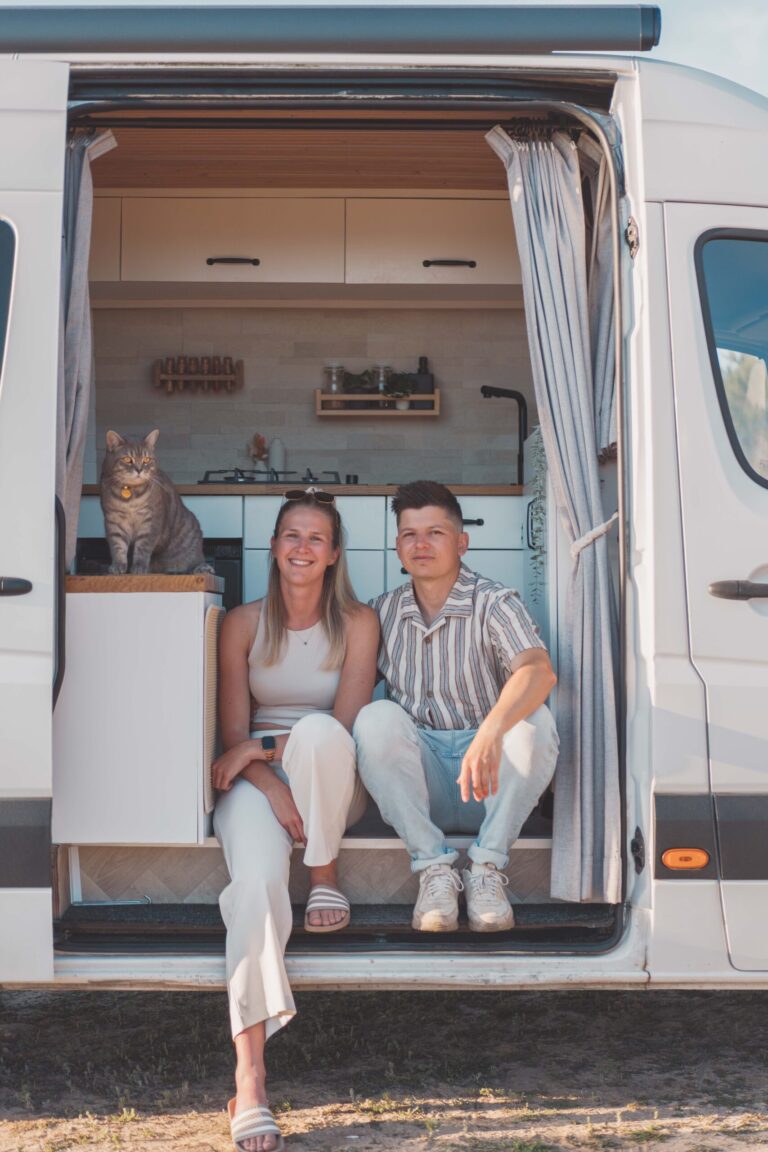Overview
Note
Before you start making holes in your bodywork, make sure it is allowed according the legislation in your country, so your van is homologated.
Place a roof hatch
Work equipment for this phase
Jigsaw or reciprocating saw
Drill with various drill bits
Screwdriver
Sealant (Sikaflex and/or Butyl Tape)
Stainless steel self-tapping screws
Putty knife
which roof hatch did we choose and why?
We had initially installed a Fiamma Vent in our camper, but because it still made a lot of noise and did not ventilate enough, we threw it out after a while and installed a MaxxFan Deluxe Smoke.
This is more silent, has a remote control and darkening (MaxxShade) can be placed under it. Another huge advantage is the fact that you can let it run while you are driving.
The MaxxShade also comes with lighting, which we felt was too cold light. Here we have removed the LED strip from the device and attached the same LED strip as the rest of our interior.
Step 1: Choose the Ideal Location
Before installing the roof hatch, carefully select the best location for optimal functionality and aesthetics. Consider factors such as interior layout, proximity to living areas, and structural support. Ensure that the chosen spot does not interfere with existing fixtures, wiring, or other components inside your camper.
Step 2: Measure and Mark the Opening
Once you’ve determined the location, use a measuring tape to mark the dimensions of the roof hatch on the exterior of your camper. Ensure the dimensions correspond to the size of the roof hatch you plan to install. Double-check your measurements to avoid errors that could lead to fitment issues later on.
Step 3: Cut the Opening
Using the marked dimensions as a guide, carefully cut the opening in the roof of your camper. Start by drilling small holes (minimum the size of your jigsaw blade) at each corner of the marked area to create a starting point for the jigsaw. Then, slowly and steadily cut along the marked lines, ensuring a smooth and accurate cut. Take caution to avoid damaging any existing wiring or structural components.
Step 4: Install the Roof Hatch
Once the opening is cut, coat the edges with hammerite so that the raw metal is protected. When it’s dry, place the roof hatch in the opening to check for fitment. Ensure it aligns properly and sits flush with the roof surface. If adjustments are needed, carefully trim the opening to achieve the desired fit. Once satisfied, secure the roof hatch in place using stainless steel self-tapping screws.
Step 5: Seal and Weatherproof
To prevent water leaks and ensure a watertight seal, apply a high-quality sealant such as Sikaflex and/or butyl tape around the perimeter of the roof hatch. Use a putty knife to spread the sealant evenly and create a solid bond between the hatch and the roof surface. Pay extra attention to corners and edges to ensure complete weatherproofing.
Tip
Also put some silicone on the heads of the screws so that no leaks can come this way either.
Step 6: Test and Finishing Touches
After the sealant has cured according to the manufacturer’s instructions, test the functionality of the roof hatch. Ensure it opens and closes smoothly and securely.
Install ventilation hole and shore plug
Work equipment for this phase
Holesaw
Drill
Sealant
Marker
Stainless steel self-tapping screws
Why do you need a ventilation hole?
Proper ventilation is crucial for maintaining a comfortable and healthy environment inside your camper. It ensures a continuous supply of fresh air and good indoor air quality. Ventilation helps to remove nasty smells, smoke, cooking fumes and other pollutants from the living space.
In colder weather, ventilation helps to prevent condensation from forming on windows, walls, and other surfaces inside the camper. Condensation occurs when warm, moist air comes into contact with colder surfaces. By providing adequate ventilation, you can reduce condensation and minimize the potential for moisture-related damage.
Identify areas where ventilation holes are needed, such as in the kitchen, bathroom, or sleeping area. With our MaxxFan in combination with a sliding window we have enough ventilation in our living space.
We have only made an extra ventilation hole in our ‘garage’ because that is also where our gas and electricity installation is located. We also added some 12v computer case fans so it will have a good airflow and we will less likely get nasty smells from outside.
it is also recommended to make a small hole in the floor near the gas bottle as gas sinks in relation to air and can escape out this way in case of a leak.
Step 1: Choose the Ideal Location
Before you start making the holes, you must first determine the location where you need ventilation. As mentioned earlier, we only need ventilation for our gas and electricity supplies. So we consulted our plans where we were going to place these supplies and looked for a place nearby where we could make these holes. In our case, at the rear right of the camper.
Step 2: Mark the Opening
Once you’ve found the right location mark it and check that there isn’t a support beam along the inside that you need to drill through. If this is the case then you will have to find another location.
Step 3: Drill the holes
Measure the diameter of your ventilation grille and your hole saw to make sure that your ventilation grille fits in the hole. Also make sure that your grille is not too small!
Normally, the manufacturer specifies the correct hole saw diameter.
If everything is in order, drill a hole straight ahead at your marked point.
Do the same for the shore plug.
Step 4: Place and install the grille and shore plug
Check if the grill and shore plug fit in the holes. If everything fits well, you should now lightly sand the rough edges and apply an anti-rust agent on the edges. Apply silicone to the back of the grill and place it straight into the hole so that the grill is placed horizontally and no water can fall in from above. Then press it into the hole, let it dry and wipe off any silicone residue with a wet finger.
When dry, apply silicone along the outside so that it is nicely sealed.
The shore plug is actually placed the same, only this time you will have the extra option to screw 4 stainless steel self-tapping screws into the body. Make sure that it is also placed horizontally.
Step 5: Test and Finishing Touches
After the sealant has cured according to the manufacturer’s instructions, test whether everything is waterproof by pouring water over it.
Disclaimer
This blog is a guide on how we converted our camper. We are not responsible for any problems or damage during the conversion of your camper.
The information on this blog is to be used at your own risk and your own judgement. You assume full responsibility and liability for your own actions.
Win-Win for everyone
Did you know that, if you buy or book something through our links, we receive a small commission?
However, you still pay the same and therefore have no extra costs! So a win-win for everyone. This way, we can continue to add even more travel inspiration and tips to this blog for your next adventure. Thanks a lot!
Thank you for visiting our blog
We hope you find our free travel guides and tips useful. If you want, you can support us virtually by ‘buying us a coffee‘.
Every contribution, no matter how small, is greatly appreciated and will help us continue to share our passion with you and grow this blog.
This blogpost was about:








